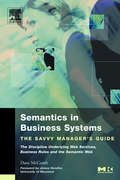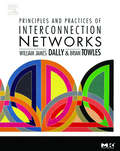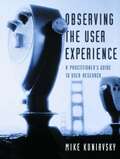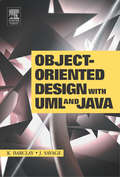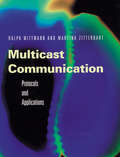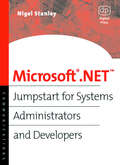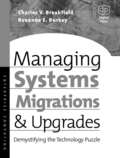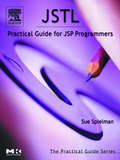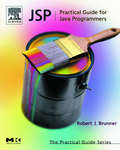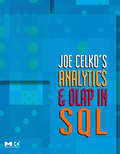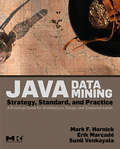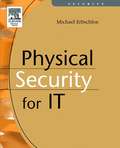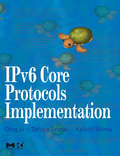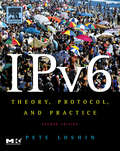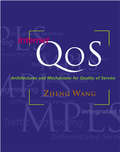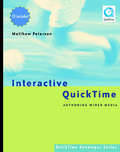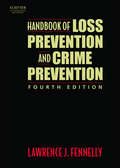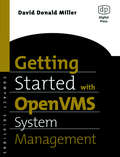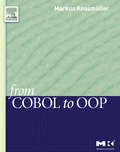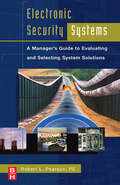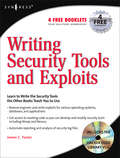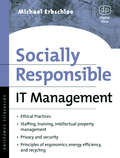- Table View
- List View
Semantics in Business Systems: The Savvy Manager's Guide (The Savvy Manager's Guides)
by Dave McCombSemantics in Business Systems begins with a description of what semantics are and how they affect business systems. It examines four main aspects of the application of semantics to systems, specifically: How do we infer meaning from unstructured information, how do application systems make meaning as they operate, how do practitioners uncover meaning in business settings, and how do we understand and communicate what we have deduced? This book illustrates how this applies to the future of application system development, especially how it informs and affects Web services and business rule- based approaches, and how semantics will play out with XML and the semantic Web. The book also contains a quick reference guide to related terms and technologies. It is part of Morgan Kaufmann's series of Savvy Manager's Guides.* Presents an easy and enjoyable introduction to semantics in the context of business IT systems.* Articulates the business value of semantics, while providing relevant introductory technical background.* Describes the semantic underpinnings of data modeling, business rules, enterprise integration, and Web services.* Contains a handy quick-reference guide to technologies and terminology. * For more information, links, and discussions, go to www.savvymanagers.com.
Principles and Practices of Interconnection Networks (ISSN)
by William James Dally Brian Patrick TowlesOne of the greatest challenges faced by designers of digital systems is optimizing the communication and interconnection between system components. Interconnection networks offer an attractive and economical solution to this communication crisis and are fast becoming pervasive in digital systems. Current trends suggest that this communication bottleneck will be even more problematic when designing future generations of machines. Consequently, the anatomy of an interconnection network router and science of interconnection network design will only grow in importance in the coming years.This book offers a detailed and comprehensive presentation of the basic principles of interconnection network design, clearly illustrating them with numerous examples, chapter exercises, and case studies. It incorporates hardware-level descriptions of concepts, allowing a designer to see all the steps of the process from abstract design to concrete implementation.Case studies throughout the book draw on extensive author experience in designing interconnection networks over a period of more than twenty years, providing real world examples of what works, and what doesn't.Tightly couples concepts with implementation costs to facilitate a deeper understanding of the tradeoffs in the design of a practical network.A set of examples and exercises in every chapter help the reader to fully understand all the implications of every design decision.
Observing the User Experience: A Practitioner's Guide to User Research
by Mike KuniavskyThe gap between who designers and developers imagine their users are, and who those users really are can be the biggest problem with product development. Observing the User Experience will help you bridge that gap to understand what your users want and need from your product, and whether they'll be able to use what you've created. Filled with real-world experience and a wealth of practical information, this book presents a complete toolbox of techniques to help designers and developers see through the eyes of their users. It provides in-depth coverage of 13 user experience research techniques that will provide a basis for developing better products, whether they're Web, software or mobile based. In addition, it's written with an understanding of how software is developed in the real world, taking tight budgets, short schedules, and existing processes into account.·Explains how to create usable products that are still original, creative, and unique·A valuable resource for designers, developers, project managers—anyone in a position where their work comes in direct contact with the end user.·Provides a real-world perspective on research and provides advice about how user research can be done cheaply, quickly and how results can be presented persuasively·Gives readers the tools and confidence to perform user research on their own designs and tune their software user experience to the unique needs of their product and its users
Object-Oriented Design with UML and Java
by Kenneth Barclay John SavageObject-Oriented Design with UML and Java provides an integrated introduction to object-oriented design with the Unified Modelling Language (UML) and the Java programming language. The book demonstrates how Java applications, no matter how small, can benefit from some design during their construction. Fully road-tested by students on the authors' own courses, the book shows how these complementary technologies can be used effectively to create quality software. It requires no prior knowledge of object orientation, though readers must have some experience of Java or other high level programming language. This book covers object technology; object-oriented analysis and design; and implementation of objects with Java. It includes two case studies dealing with library applications. The UML has been incorporated into a graphical design tool called ROME, which can be downloaded from the book's website. This object modelling environment allows readers to prepare and edit various UML diagrams. ROME can be used alongside a Java compiler to generate Java code from a UML class diagram then compile and run the resulting application for hands-on learning. This text would be a valuable resource for undergraduate students taking courses on O-O analysis and design, O-O modelling, Java programming, and modelling with UML.* Integrates design and implementation, using Java and UML* Includes case studies and exercises * Bridges the gap between programming texts and high level analysis books on design
Multicast Communication: Protocols, Programming, & Applications (ISSN)
by Ralph Wittmann Martina ZitterbartThe Internet is quickly becoming the backbone for the worldwide information society of the future. Point-to-point communication dominates the network today, however, group communication--using multicast technology--will rapidly gain importance as digital, audio, and video transmission, push technology for the Web, and distribution of software updates to millions of end users become ubiquitous.Multicast Communication: Protocols and Applications explains how and why multicast technology is the key to this transition. This book provides network engineers, designers, and administrators with the underlying concepts as well as a complete and detailed description of the protocols and algorithms that comprise multicast.* Presents information on the entire range of multicast protocols, including, PIM-SM, MFTP, and PGM and explains their mechanisms, trade-offs, and solid approaches to their implementation* Provides an in-depth examination of Quality of Service concepts, including: RSVP, ST2, IntServ, and DiffServ* Discusses group address allocation and scoping* Discusses multicast implementation in ATM networks* Builds a solid understanding of the Mbone and surveys the successes and current limitations of real multicast applications on the Internet such as videoconferencing, whiteboards, and distance learning
Microsoft .NET: Jumpstart for Systems Administrators and Developers
by Nigel StanleyMicrosoft .NET is born out of a personal search for the Holy Grail of .NET for IT professionals. Unlike competing texts, it focuses on actual implementation and management issues critical to the success of an enterprise. Through Nigel Stanley's active consulting practice, he has gathered essential information for integrating the far-ranging components which .NET touches without hype or superfluous programming details.Microsoft .NET revolutionizes the development, deployment and support of business applications. It introduces new technologies and concepts which have to be understood by today's IT professionals if they are to continue to be successful.· Clear coverage of all the major .NET Enterprise Server products· Introductions to important technologies such as SOAP, UDDI and XML· Experiences drawn from real life customer situations focusing on important need-to-know material for the IT professional · Appendix giving detailed specifications required to run the .NET Enterprise Servers.
Managing Systems Migrations and Upgrades: Demystifying the Technology Puzzle
by Roxanne Burkey Charles BreakfieldManaging Systems Migrations and Upgrades is the perfect book for technology managers who want a rational guide to evaluating the business aspects of various possible technical solutions. Enterprises today are in the middle of the R&D race for technology leadership, with providers who increasingly need to create markets for new technologies while shortening development, implementation, and life cycles. The cost for the current tempo of technology life cycles is endless change-management controls, organizational chaos, production use of high-risk beta products, and greater potential for failure of existing systems during migration.Burkey and Breakfield help you answer questions such as, "Is the only solution open to me spending more that the industry average in order to succeed?" and "What are the warning signs that tell me to pass on a particular product offering?" as well as "How can my organization avoid the 'technical death marches' typical of the industry?" This book will take the confusion out of when to make shifts in your systems and help you evaluate the value proposition of these technology changes.· Provides a methodology for decision making and implementation of upgrades and migrations· Avoids marketing hype and the "technical herding" instinct· Offers a tool to optimize technology changes for both staff and customers
JSTL: Practical Guide for JSP Programmers (The Practical Guides)
by Sue SpielmanWeb developers and page authors who use JavaServer Pages (JSP) know that it is much easier and efficient to implement web pages without reinventing the wheel each time. In order to shave valuable time from their development schedules, those who work with JSP have created, debugged, and used custom tags—a set of programmable actions that provide dynamic behavior to static pages—paving the way towards a more common, standard approach to using Java technology for web development. The biggest boost to this effort however has only recently arrived in the form of a standard set of tag libraries, known as the JSTL, which now provides a wide range of functionality and gives web page authors a much more simplified approach to implementing dynamic, Java-based web sites. JSTL: Practical Guide for JSP Programmers is a timely resource for anyone interested in doing large-scale J2EE application development. It sticks to the main features of the JSTL so that developers don't have to sift through unnecessary details to begin using the tags and working with the expression language. Sue Spielman's straight-forward, practical approach is enhanced with numerous code samples and insightful descriptions to make learning the JSTL a quickly and easily accomplished task.Written by a best-selling author with a wealth of development experience and recognition in the Java community.Covers the core elements of the JSTL including the four standard tag libraries (core, internationalization/format, XML, and SQL) and expression language.Includes a reference section for all of the tabs and attributes contained in the JSTL.
JSP: Practical Guide for Programmers (The Practical Guides)
by Robert BrunnerJavaServer Pages (JSP) is a technology for building dynamic web applications that can access databases and provide an interactive experience for users. It's a powerful technology with open source implementations (server and platform independent) for building enterprise Web applications. With JSP, existing business systems can be leveraged with minimal overhead, maintenance, and support. JSP: Practical Guide for Java Programmers is designed to cover the essentials of JSP including the basic JSP constructs and the relevant implicit objects as well as more advanced concepts such as incorporating JavaBeans, developing custom tags, utilizing the JSP expression language, building with the JSP Standard Tag Library, and developing complete JSP-Servlet application.Covers the latest release of JSP, version 2.0, and covers new features such as the Expression Language and Standard Tag Library.Includes a sample application of an electronic bank Web site, showing the power of JSP in providing the foundation for building Web applications.Provides a clear, straight-to-the-point approach to the JSP so that readers can start using it in their own projects right away.
Joe Celko's Analytics and OLAP in SQL (The Morgan Kaufmann Series in Data Management Systems)
by Joe CelkoJoe Celko's Analytics and OLAP in SQL is the first book that teaches what SQL programmers need in order to successfully make the transition from On-Line Transaction Processing (OLTP) systems into the world of On-Line Analytical Processing (OLAP). This book is not an in-depth look at particular subjects, but an overview of many subjects that will give the working RDBMS programmers a map of the terra incognita they will face — if they want to grow. It contains expert advice from a noted SQL authority and award-winning columnist, who has given ten years of service to the ANSI SQL standards committee and many more years of dependable help to readers of online forums. It offers real-world insights and lots of practical examples. It covers the OLAP extensions in SQL-99; ETL tools, OLAP features supported in DBMSs, other query tools, simple reports, and statistical software. This book is ideal for experienced SQL programmers who have worked with OLTP systems who need to learn techniques—and even some tricks—that they can use in an OLAP situation.Expert advice from a noted SQL authority and award-winning columnist, who has given ten years of service to the ANSI SQL standards committee and many more years of dependable help to readers of online forumsFirst book that teaches what SQL programmers need in order to successfully make the transition from transactional systems (OLTP) into the world of data warehouse data and OLAPOffers real-world insights and lots of practical examplesCovers the OLAP extensions in SQL-99; ETL tools, OLAP features supported in DBMSs, other query tools, simple reports, and statistical software
Java Data Mining: A Practical Guide for Architecture, Design, and Implementation (The Morgan Kaufmann Series in Data Management Systems)
by Mark F. Hornick Erik Marcadé Sunil VenkayalaWhether you are a software developer, systems architect, data analyst, or business analyst, if you want to take advantage of data mining in the development of advanced analytic applications, Java Data Mining, JDM, the new standard now implemented in core DBMS and data mining/analysis software, is a key solution component. This book is the essential guide to the usage of the JDM standard interface, written by contributors to the JDM standard.Data mining introduction - an overview of data mining and the problems it can address across industries; JDM's place in strategic solutions to data mining-related problemsJDM essentials - concepts, design approach and design issues, with detailed code examples in Java; a Web Services interface to enable JDM functionality in an SOA environment; and illustration of JDM XML Schema for JDM objectsJDM in practice - the use of JDM from vendor implementations and approaches to customer applications, integration, and usage; impact of data mining on IT infrastructure; a how-to guide for building applications that use the JDM APIFree, downloadable KJDM source code referenced in the book available here
Physical Security for IT
by Michael ErbschloeThe physical security of IT, network, and telecommunications assets is equally as important as cyber security. We justifiably fear the hacker, the virus writer and the cyber terrorist. But the disgruntled employee, the thief, the vandal, the corporate foe, and yes, the terrorist can easily cripple an organization by doing physical damage to IT assets. In many cases such damage can be far more difficult to recover from than a hack attack or malicious code incident. It does little good to have great computer security if wiring closets are easily accessible or individuals can readily walk into an office and sit down at a computer and gain access to systems and applications. Even though the skill level required to hack systems and write viruses is becoming widespread, the skill required to wield an ax, hammer, or fire hose and do thousands of dollars in damage is even more common. Although many books cover computer security from one perspective or another, they do not thoroughly address physical security. This book shows organizations how to design and implement physical security plans. It provides practical, easy-to-understand and readily usable advice to help organizations to improve physical security for IT, network, and telecommunications assets.* Expert advice on identifying physical security needs* Guidance on how to design and implement security plans to prevent the physical destruction of, or tampering with computers, network equipment, and telecommunications systems* Explanation of the processes for establishing a physical IT security function* Step-by-step instructions on how to accomplish physical security objectives* Illustrations of the major elements of a physical IT security plan* Specific guidance on how to develop and document physical security methods and procedures
IPv6 Core Protocols Implementation (ISSN)
by Qing Li Tatuya Jinmei Keiichi ShimaIPv6 was introduced in 1994 and has been in development at the IETF for over 10 years. It has now reached the deployment stage. KAME, the de-facto open-source reference implementation of the IPv6 standards, played a significant role in the acceptance and the adoption of the IPv6 technology. The adoption of KAME by key companies in a wide spectrum of commercial products is a testimonial to the success of the KAME project, which concluded not long ago. This book is the first and the only one of its kind, which reveals all of the details of the KAME IPv6 protocol stack, explaining exactly what every line of code does and why it was designed that way. Through the dissection of both the code and its design, the authors illustrate how IPv6 and its related protocols have been interpreted and implemented from the specifications. This reference will demystify those ambiguous areas in the standards, which are open to interpretation and problematic in deployment, and presents solutions offered by KAME in dealing with these implementation challenges.Covering a snapshot version of KAME dated April 2003 based on FreeBSD 4.8Extensive line-by-line code listings with meticulous explanation of their rationale and use for the KAME snapshot implementation, which is generally applicable to most recent versions of the KAME IPv6 stack including those in recent releases of BSD variantsNumerous diagrams and illustrations help in visualizing the implementation In-depth discussion of the standards provides intrinsic understanding of the specifications
IPv6: Theory, Protocol, and Practice (ISSN)
by Peter LoshinThe second edition of IPv6: Theory, Protocol, and Practice guides readers through implemetation and deployment of IPv6. The Theory section takes a close, unbiased look at why so much time and effort has been expended on revising IPv4. In the Protocol section is a comprehensive review of the specifics of IPv6 and related protocols. Finally, the Practice section provides hands-on explanations of how to roll out IPv6 support and services.This completely rewritten edition offers updated and comprehensive coverage of important topics including router and server configuration, security, the impact of IPv6 on mobile networks, and evaluating the impact of IPv6-enabled networks globally. Pete Loshin's famously lucid explanations benefit readers at every turn, making Ipv6: Theory, Protocol, and Practice the best way for a large diverse audience to get up to speed on this groundbreaking technology.The comprehensive, accessible, and up-to-date resource needed by network engineers and support staff, product developers and managers, programmers, and marketing professionalsDivided into sections on theory, the protocol's technical details, and techniques for building Ipv6 networks, this book covers not only the protocol but the ways in which the protocol can be integrated into networksCovers critical topics in depth, including router and server configuration, security, value assessment, and the impact of Ipv6 on global networks
Internet QoS: Architectures and Mechanisms for Quality of Service (ISSN)
by Zheng WangGuaranteeing performance and prioritizing data across the Internet may seem nearly impossible because of an increasing number of variables that can affect and undermine service. But if you're involved in developing and implementing streaming video or voice, or other time-sensitive Internet applications, you understand exactly what's at stake in establishing Quality of Service (QoS) and recognize the benefits it will bring to your company. What you need is a reliable guide to the latest QoS techniques that addresses the Internet's special challenges. Internet QoS is it-the first book to dig deep into the issues that affect your ability to provide performance and prioritization guarantees to your customers and users! This book gives a comprehensive view of key technologies and discusses various analytical techniques to help you get the most out of network resources as you strive to make, and adhere to, meaningful QoS guarantees.* Includes valuable insights from a Bell Labs engineer with 14 years of experience in data networking and Internet protocol design.* Details the enhancements to current Internet architectures and discusses new mechanisms and network management capabilities that QoS will require. * Focuses on the four main areas of Internet QoS: integrated services, differentiated services, MPLS (Multiprotocol Label Switching), and traffic engineering.
Interactive QuickTime: Authoring Wired Media (QuickTime Developer Series)
by Matthew R. PetersonInteractivity is one of the most captivating topics for today's online community. It is a fast-growing field pushed by the rapid development and dispersion of Java, Shockwave, Flash, and QuickTime. While several good books are available about the interactive capabilities of Java, Shockwave, and Flash, until now there hasn't been a book about QuickTime interactivity. A logical follow-up to QuickTime for the Web, this eagerly awaited book by Matthew Peterson details the power of QuickTime's wired media technology and provides a resource for professionals developing and deploying interactive QuickTime content. This content can extend far beyond simple movies—it can act as application user interfaces, educational multimedia, scientific display panels, musical instruments, games and puzzles, etc., and can interact with you, your browser, a server, or with other movies.Describes concepts and techniques of interactivity applicable to technologies beyond QuickTime—including Flash.Features real-world, hands-on projects of progressive sophistication allowing developers to start with a project appropriate to their own level of QuickTime experience.
Handbook of Loss Prevention and Crime Prevention
by Lawrence J. FennellyThe Handbook of Loss Prevention and Crime Prevention, Fourth Edition, is the most comprehensive reference of its kind, covering the latest information on every topic from community-oriented policing to physical security, workplace violence, CCTV, information security, homeland security, and a host of specialty areas. The handbook shows how to prevent or minimize corporate losses, including security breaches, theft, and lack of resources due to natural or man-made disaster. This revised volume brings together the expertise of more than forty security and crime prevention experts who provide practical information and advice. Each chapter provides a wealth of information that can be put to use immediately. This is a must-have reference for security managers, security students, and all levels of security professionals.Covers every important topic in the field, including the latest on high-tech security systems, homeland security, and many specialty areasBrings together the expertise of more than 40 security and crime prevention expertsEach chapter provides a wealth of practical information that can be put to use immediately
Getting Started with OpenVMS System Management (HP Technologies)
by David MillerGetting Started with OpenVMS System Management gives new VMS system managers a jumpstart in managing this powerful and reliable operating system. Dave Miller describes the essentials of what an OpenVMS System Manager will have to manage. He defines areas of OpenVMS System Management and describes why each is important and how it fits into the larger management task. Even though some OpenVMS management concepts are unique (for instance quotas), many concepts (such as account creation) have counterparts in UNIX and Windows NT. So, wherever possible, Miller points out to his readers the parallel to other systems.The book is intended as a precursor to Baldwin's OpenVMS System Management Guide and various OpenVMS documents. Thus it refers the reader to other books for the detailed management steps. Getting Started with OpenVMS System Management is a great introduction to the material Steve Hoffman and Dave Miller are revising for the OpenVMS System Management Guide, 2E.· Permits experienced system managers to begin managing OpenVMS more quickly · Dovetails with other Digital Press publications for easier reference by the OpenVMS manager · Points you in the right direction for the complete documentation on each issue· BONUS FEATURE! Includes excerpts from five key DP OpenVMS books
From COBOL to OOP (The Morgan Kaufmann Series in Software Engineering and Programming)
by Markus KnasmüllerDriven by the year-2000 problem, the hordes of COBOL developers experienced a renaissance, but the times when COBOL was state-of-the-art are long gone. Object-orientation, application servers, web front-ends, and relational database systems dominate the scene for new projects today. The fact remains however, that millions of lines of source code written in the structured programming language COBOL work daily on computer systems all over the world. One problem that COBOL developers have to deal with on these new projects is familiarity with object-oriented concepts. Markus Knasmüller, rich with experiences of OO projects in COBOL development teams, offers a successful introduction for the experienced COBOL programmer. A careful approach across techniques familiar to COBOL developers and discussions of current standards make this book easily accessible and understandable.*A practical approach to OOP using the concepts and techniques familiar to the experienced COBOL programmer.*Written independently from any specific programming environment, and all programming examples written in both Delphi and Java. *Detailed case study describing the successful migration of 10 million lines of COBOL code to object-oriented programming.*Companion CD-ROM containing all tutorial sections of the book in PowerPoint and all sample solutions to the problems ready for compilation.
Electronic Security Systems: A Manager's Guide to Evaluating and Selecting System Solutions
by Robert PearsonElectronic Security Systems is a book written to help the security professional understand the various electronic security functional components and the ways these components interconnect. Providing a holistic approach to solving security issues, this book discusses such topics as integrating electronic functions, developing a system, component philosophy, possible long-term issues, and the culture within a corporation. The book uses a corporate environment as its example; however, the basic issues can be applied to virtually any environment.For a security professional to be effective, he or she needs to understand the electronics as they are integrated into a total security system. Electronic Security Systems allows the professional to do just that, and is an invaluable addition to any security library.* Provides a well-written and concise overview of electronic security systems and their functions* Takes a holistic approach by focusing on the integration of different aspects of electronic security systems* Includes a collection of practical experiences, solutions, and an approach to solving technical problems
Writing Security Tools and Exploits
by James C FosterWriting Security Tools and Exploits will be the foremost authority on vulnerability and security code and will serve as the premier educational reference for security professionals and software developers. The book will have over 600 pages of dedicated exploit, vulnerability, and tool code with corresponding instruction. Unlike other security and programming books that dedicate hundreds of pages to architecture and theory based flaws and exploits, this book will dive right into deep code analysis. Previously undisclosed security research in combination with superior programming techniques will be included in both the Local and Remote Code sections of the book. The book will be accompanied with a companion Web site containing both commented and uncommented versions of the source code examples presented throughout the book. In addition to the book source code, the CD will also contain a copy of the author-developed Hacker Code Library v1.0. The Hacker Code Library will include multiple attack classes and functions that can be utilized to quickly create security programs and scripts. These classes and functions will simplify exploit and vulnerability tool development to an extent never before possible with publicly available software.* Provides readers with working code to develop and modify the most common security tools including Nmap and Nessus* Learn to reverse engineer and write exploits for various operating systems, databases, and applications* Automate reporting and analysis of security log files
Fault-Tolerant Systems
by Israel Koren C. Mani KrishnaFault-Tolerant Systems is the first book on fault tolerance design with a systems approach to both hardware and software. No other text on the market takes this approach, nor offers the comprehensive and up-to-date treatment that Koren and Krishna provide. This book incorporates case studies that highlight six different computer systems with fault-tolerance techniques implemented in their design. A complete ancillary package is available to lecturers, including online solutions manual for instructors and PowerPoint slides. Students, designers, and architects of high performance processors will value this comprehensive overview of the field.The first book on fault tolerance design with a systems approachComprehensive coverage of both hardware and software fault tolerance, as well as information and time redundancyIncorporated case studies highlight six different computer systems with fault-tolerance techniques implemented in their designAvailable to lecturers is a complete ancillary package including online solutions manual for instructors and PowerPoint slides
Uva's Guide To Cranes, Dollies, And Remote Heads
by Michael Uva Sabrina UvaFirst Published in 2001. Routledge is an imprint of Taylor & Francis, an informa company.
TCP/IP Sockets in C#: Practical Guide for Programmers (The Practical Guides)
by Kenneth L. Calvert Michael J. Donahoo David Makofske"TCP/IP sockets in C# is an excellent book for anyone interested in writing network applications using Microsoft .Net frameworks. It is a unique combination of well written concise text and rich carefully selected set of working examples. For the beginner of network programming, it's a good starting book; on the other hand professionals could also take advantage of excellent handy sample code snippets and material on topics like message parsing and asynchronous programming."Adarsh Khare, SDT, .Net Frameworks Team, Microsoft CorporationThe popularity of the C# language and the .NET framework is ever rising due to its ease of use, the extensive class libraries available in the .NET Framework, and the ubiquity of the Microsoft Windows operating system, to name a few advantages. TCP/IP Sockets in C# focuses on the Sockets API, the de facto standard for writing network applications in any programming language. Starting with simple client and server programs that use TCP/IP (the Internet protocol suite), students and practitioners quickly learn the basics and move on to firsthand experience with advanced topics including non-blocking sockets, multiplexing, threads, asynchronous programming, and multicasting. Key network programming concepts such as framing, performance and deadlocks are illustrated through hands-on examples. Using a detailed yet clear, concise approach, this book includes numerous code examples and focused discussions to provide a solid understanding of programming TCP/IP sockets in C#.Features*Tutorial-based instruction in key sockets programming techniques complemented by numerous code examples throughout *Discussion moves quickly into the C# Sockets API definition and code examples, desirable for those who want to get up-to-speed quickly*Important coverage of "under the hood" details that developers will find useful when creating and using a socket or a higher level TCP class that utilizes sockets*Includes end-of-chapter exercises to facilitate learning, as well as sample code available for download at the book’s companion web site*Tutorial-based instruction in key sockets programming techniques complemented by numerous code examples throughout *Discussion moves quickly into the C# Sockets API definition and code examples, desirable for those who want to get up-to-speed quickly*Important coverage of "under the hood" details that developers will find useful when creating and using a socket or a higher level TCP class that utilizes sockets*Includes end-of-chapter exercises to facilitate learning, as well as sample code available for download at the book's companion web site
Socially Responsible IT Management
by Michael ErbschloeSocially Responsible IT Management shows IT professionals how to overcome the social crisis that has resulted from the wide-spread use of information technology. By responsibly managing security threats, protecting individual privacy, reducing hazardous waste, and minimizing other negative effects on IT staff and computer users, as well as ordinary citizens around the world, IT professionals can benefit the society at large and reap rewards for their own organizations as well.Scandals at Enron, Andersen, Sotheby's and Christie's, Merrill Lynch, and Tyco are fueling a crisis of confidence in business. Regulators, voters, investors, customers, and employees are demanding that businesses be more socially responsible. Rhetoric is not enough, all organizations need to demonstrate that they are living up to social expectations. Erbschloe shows managers how to take charge of key aspects of their IT operations and follow a morally, ethically, and legally correct path to success.· Supported by author speaking tour and "Computer Economics" website, www.computereconomics.com · Step-by-step instructions on how to accomplish objectives of privacy and security· Explains principles of ergonomics, energy efficiency, and recycling that can bring return on investment
